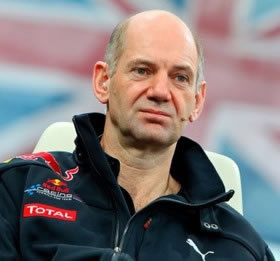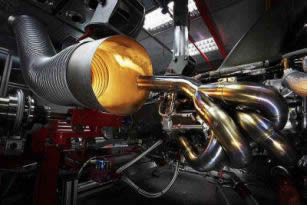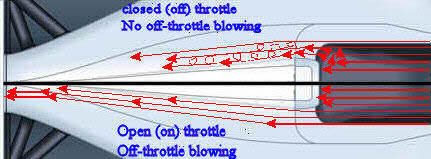Engine Off - Throttle Overrun

Red Bull's Adrian Newey initially pioneered the new generation of blown diffusers and he positioned exhaust outlet low above the floor of the Red Bull RB6. This was extremely beneficial to energize airflow going through and over the diffuser. This kind of diffuser was known as Blown diffuser. Basically, teams have been blowing exhaust gases over the rear floor of their cars even when the driver is off the accelerator going into a corner.
There are two way to blow a diffuser – hot and cold.
In Thursday's Press Conference at Monaco 2011, Adrian Newey apparently tried to defend the legality of exhaust-blown diffusers on the over-run, by claiming that the primary function of an open throttle on the over-run is to cool the exhaust valves:
"In the case of Renault, (RedBull Racing engine supplier) when they open the throttle to full open on the over-run for exhaust valve cooling, and that's part of the reliability of the engine...Obviously if other people are going further and perhaps firing the engine on the over-run then clearly exhaust valve cooling is not part of that and that would be something that presumably they would need to explain to keep Charlie (Whiting, Fia technical delegate) happy."
Much more about blown diffuser you can read here, but just short recap:
What is a blown diffuser?
On road cars, the engine exhaust exits are normally located at the rear of the car. On a Formula One car they are deliberately located in front of the rear wheels so that the hot, fast flowing exhaust gases can be channeled towards the car’s diffuser. This increases airflow through the diffuser and in turn increases the amount of downforce the diffuser produces. This is perfectly legal under current F1 regulations.
What is „cold blowing“?
Normally the engine will only produce exhaust gases requested for good diffuser blowing when the driver is on the throttle. This means when the driver lifts off, the blown diffuser is suddenly deprived of the additional airflow. To get around this, some teams have modified their engine mapping so that when the driver lifts off, although fuel supply and ignition are cut, airflow through the exhaust to the diffuser continues. This technique has become known as ‘cold blowing’ - the exhaust is still ‘blowing’ into the diffuser, but that airflow is now ‘cold’ since no fuel or ignition is involved. Renault is using this technique.
What is „hot blowing’?
Some teams (read Mclaren and Ferrari) have taken things a step further. To make the off-throttle ‘blowing’ as similar ( hot and fast flowing gasses) to the on-throttle ‘blowing’ as possible, they cut the ignition (supply for sparkplugs) when the driver lifts off the throttle, but continue to inject some fuel through the engine’s valves into the exhaust. This fuel ignites on the hot exhaust, increasing the amount, speed and temperature of the airflow exiting towards the diffuser.
 Leading engineers say hot-blowing can give an advantage of as much as second a lap over no blowing at all, while cold-blowing is worth about 0.3-0.4 second over no blowing at all. The row started when the FIA decided to introduce a limit of 10% of throttle when the driver was not pressing the accelerator.
Leading engineers say hot-blowing can give an advantage of as much as second a lap over no blowing at all, while cold-blowing is worth about 0.3-0.4 second over no blowing at all. The row started when the FIA decided to introduce a limit of 10% of throttle when the driver was not pressing the accelerator.
The brief history of it is that Charlie Whiting, head of the FIA technical department, feels that the use of exhaust gas to create downforce is illegal. This comes from the regulation change that bans the F-Duct, which says “no driver movement shall deliberately affect the aerodynamics of the car”. Clearly this involved driver movement (a foot lifting off the accelerator pedal).
Therefore any engine mapping with the prime purpose of using the engine as a thrust-producer is illegal. Charlie issued a series of technical directives to that intent culminating in a technical directive, which came to teams roughly two weeks ago, a bit before Valencia GP 2011. It said hot-blowing – ie fuelling and igniting on over-run – is banned and for cold-blowing – ie without injection and ignition – the maximum throttle opening would be 20 per cent at 18,000 rpm tapering to 10 per cent at 12,000 rpm.
 It seems that Mercedes in particular lobbied that they should be able to retain over-run (with zero pedal) fired by 4 cylinders (half the cylinders in an F1 engine). They persuaded Charlie they were doing that in 2009 for the prime purpose of brake balance modification and therefore should be allowed to continue doing so for reliability reasons. Charlie’s philosophy is that things teams did prior to using the exhaust to create downforce should still be legal. So Charlie agreed to what Mercedes requested.
It seems that Mercedes in particular lobbied that they should be able to retain over-run (with zero pedal) fired by 4 cylinders (half the cylinders in an F1 engine). They persuaded Charlie they were doing that in 2009 for the prime purpose of brake balance modification and therefore should be allowed to continue doing so for reliability reasons. Charlie’s philosophy is that things teams did prior to using the exhaust to create downforce should still be legal. So Charlie agreed to what Mercedes requested.
 Renault engines had been operating from 2009 with a strategy of running throttles 50 per cent open (so called cold-blowing) on over-run for reasons of throttle response and engine braking balance. As this was also for non-downforce generating reasons, Renault believed they should be allowed to continue doing it, for the same reason Mercedes were allowed to continue hot-blowing. So Charlie agreed to allow 50% of throttle opening for Renault.
Renault engines had been operating from 2009 with a strategy of running throttles 50 per cent open (so called cold-blowing) on over-run for reasons of throttle response and engine braking balance. As this was also for non-downforce generating reasons, Renault believed they should be allowed to continue doing it, for the same reason Mercedes were allowed to continue hot-blowing. So Charlie agreed to allow 50% of throttle opening for Renault.
But Renault’s rivals object because the French engine company has now been allowed to have a 50% throttle opening when the driver is lifting the throttle.
This is what Whitmarsh calls “a very substantial performance benefit”. To which Horner responds: “Why is it any more of a performance benefit than fired overrun?”
Leading Formula One engineers have spoken out about the influence of cold and hot blown diffusers, and how their teams have had to adopt their cars for the upcoming rule change. As I can see, a lot of fans on forums think that this is a quite simple thing of matter to change these configurations of engine mappings. No problem, change a few parameters and things is done.
But it's not that simple, and it affects how you operate the engine.
We need to understand what is going on within the engine when a driver lifts off the throttle and the subsequent effect that has on other aspects of the car. Unlike in road cars the driver in an F1 car does not leisurely lift off the throttle and delay the braking phase. Instead the driver may be at near maximum revs, when he will simultaneously lift off the throttle pedal completely and hit the brake pedal hard for the initial downforce aided braking. During the braking, the lower gears will be sequentially selected, further peaking revs all the time as the car slows down. This sudden closing of the throttles blocks the inlet to the combustion chamber, but the pistons in the cylinders will continue to pump up and down at a great speed. This creates huge stresses inside the combustion chamber and the vacuum created will suck air past the piston rings (so called blow-by). This will rapidly slow the engine, creating too much engine braking effect, which in turns creates stresses in the drive train and over-brakes the engine. The excessive engine braking effect will make the car nervous on throttle lift off, regardless of any subsequent aerodynamic effect. So engine manufacturers find different solutions to ease the stresses and braking effect of the driver lifting off the throttle.
In the past there were several different engine strategies in place and the driver was able to change overrun setting to tunes the cars handling, and driver switching between teams found the change in overrun settings needed some adjustment to both their driving style and sometimes with the engines settings.
Renault engine for example runs open throttles on the overrun (but no fuel injected or spark), this both eases the blow-by, reducing the vacuum effect inside the pistons and stress issues, it also useful for cooling the exhaust valves, as a great alternative to using excess fuel to cool the back of the valve. Renault sport is believed to be running as much as 90% open throttle on the overrun. This is what's best known as cold-blown mapping. During this season and through out free practice, the three Renault engined teams, had a distinctive loud overrun note, which continues briefly as the drivers picked up the throttle out of slow turns. As the throttles are open more than other teams, the induction noise is far greater.
 Mercedes High Performance Engine manufacturer have their solution, this is the so called fired or hot overrun. When the driver lifts off, fuel continues to be injected into the engine and spark fired within the combustion chamber but ignition was delayed as much as 45%. This offsets the engine braking effect created by the engine, giving a smoother transition from on throttle to the overrun when off it and again reducing the vacuum effect inside the pistons and stress issues. As a result this means there is less engine braking effect. This gives Mercedes the freedom to define braking bias and KERS charging, without having to account for engine braking. Effectively decoupling the engine braking effect from the actual action of the braking system. As with Renault's mapping in past times, Mercedes solution is analogous to the hot blowing mapping. At pre Silverstone free practices and races, Mercedes engined teams had a particularly clean overrun sound. Where as Ferrari had far more cracks and pops as the engine slowed.
Mercedes High Performance Engine manufacturer have their solution, this is the so called fired or hot overrun. When the driver lifts off, fuel continues to be injected into the engine and spark fired within the combustion chamber but ignition was delayed as much as 45%. This offsets the engine braking effect created by the engine, giving a smoother transition from on throttle to the overrun when off it and again reducing the vacuum effect inside the pistons and stress issues. As a result this means there is less engine braking effect. This gives Mercedes the freedom to define braking bias and KERS charging, without having to account for engine braking. Effectively decoupling the engine braking effect from the actual action of the braking system. As with Renault's mapping in past times, Mercedes solution is analogous to the hot blowing mapping. At pre Silverstone free practices and races, Mercedes engined teams had a particularly clean overrun sound. Where as Ferrari had far more cracks and pops as the engine slowed.
![]() Cosworth engines are using same system as Renault to ease stresses on their engines and transmissions.
Cosworth engines are using same system as Renault to ease stresses on their engines and transmissions.
With all engine manufacturers having long established overrun strategies that have critical impacts on the basic engine design or the braking system, it was hard to rapidly switch to a very strict overrun mapping as demanded by the blown diffuser rule after Valencia GP race 2011. Renault and Mercedes lobbied the FIA to be allowed to retain elements of these old overrun strategies, while still emasculating their current strategies. The FIA have been able to see the mappings used in 2009 through to the current day, as the ECU code is held by the FIA since the advent of the single ECU. They've been able to see the engines have had these long established mappings, but also how they have become more aggressive since the "Blown Diffuser"has been developed.
So the FIA relented. This sounds like a climb down by the FIA and unfair to different engine manufacturers. But the unreported events at Silverstone are fairer than the picture being painted by the teams and the media. Its true that Renault were given their greater throttle opening, but also Mercedes were given their fired-overrun, but these dispensations have been given to every engine manufacturer, so Ferrari could have more throttle opening or Cosworth could develop a fired overrun.
A couple of weeks ago I find an excellent article on Gordon McCabe blog explaining one phenomenon regarding Formula 1 airbox and Airbox air spillage. Link on this article you can find here. Picture is my small add.
Monday, October 31, 2011
 |
Just to make it clear for normal people. Under full throttle (lover half of the image), all air approaching airbox is sucked inside, trough engine and out trough exhaust. Same happened with hot or cold blowing. Engine pumps all air in. So, no air spillage around airbox. |
A couple of weeks ago, the FIA issued a Technical Directive to the Formula One teams, announcing that off-throttle blowing of the exhausts will be severely curtailed in 2012 by engine mapping restrictions.
In combination with stringent requirements on the position and angle of the exhaust exits, this is intended to minimise the exploitation of exhaust flow for aerodynamic purposes. It will, however, have a secondary consequence. As Gary Anderson recently explained, off-throttle exhaust flow also serves to reduce spillage from the airbox:
"In the past when the driver closed the throttle to slow for a corner, the airbox spillage became a lot worse. If the airflow attachment on the sides of the engine cover was not good, the performance of the rear wing would be compromised – not something the driver wants under braking or on corner entry.
"Step forward the blown diffuser. Hot or cold blowing allows the engine to work like an air pump, moving this airflow through (Airbox) and out of the exhausts. This reduces the potential turbulent airflow creating negative performance on the rear wing.
If off-throttle blowing of the exhausts is genuinely to be prohibited next year by means of engine mapping restrictions, this will presumably re-create the problem of airflow spilling out of the airbox when the driver lifts off the throttle on turn-in to a corner.
So here's an idea: Why not introduce a fluidic switch which, under certain circumstances, re-routes the airbox airflow through the chassis to the lower leading edge of the sidepods? This could have the joint benefit of boosting the velocity of the underbody flow, and improving airflow to the rear wing, just at the time when the driver most needs it, when the car is in pitch under braking and turn-in.






